Abstract
The oxidation of low-density lipoprotein (LDL) is implicated in atherosclerosis. Lipids and oxidized lipids were analysed by gas chromatography and gas chromatography-mass spectrometry in human LDL incubated with mouse peritoneal macrophages (MPM) or copper (II) sulphate in Ham's F-10 medium or medium alone (control). MPM-modification and copper-catalysed oxidation of LDL resulted in the formation of oxysterols, mainly cholest-5-en-3 beta,7 beta-diol (7 beta-OH-CHOL); 7%-19% of the initial cholesterol was converted to 7 beta-OH-CHOL in 24 h. 7 beta-OH-CHOL levels in control LDL were very low. The increase in 7 beta-OH-CHOL in MPM and copper-oxidized LDL was accompanied by decreases in linoleate and arachidonate and increases in the electrophoretic mobility and degradation of LDL protein by 'target' macrophages. The concerted occurrence of these processes and their similarity in both MPM-modification and copper-catalysed oxidation of LDL were suggested by the highly significant cross-correlations. The fall in polyunsaturated fatty acid (PUFA) was accompanied by a directly proportional increase in electrophoretic mobility of the LDL. Production of 7 beta-OH-CHOL and protein degradation by macrophages showed modest elevations during the initial steep fall in PUFA, and showed their greatest increases as the levels of PUFA slowly approached zero. The levels of 7 beta-OH-CHOL and the degradation of LDL by macrophages were directly proportional. The degradation of LDL by macrophages increased rapidly as the electrophoretic mobility of LDL was slowly approaching its maximum level.
Full text
PDF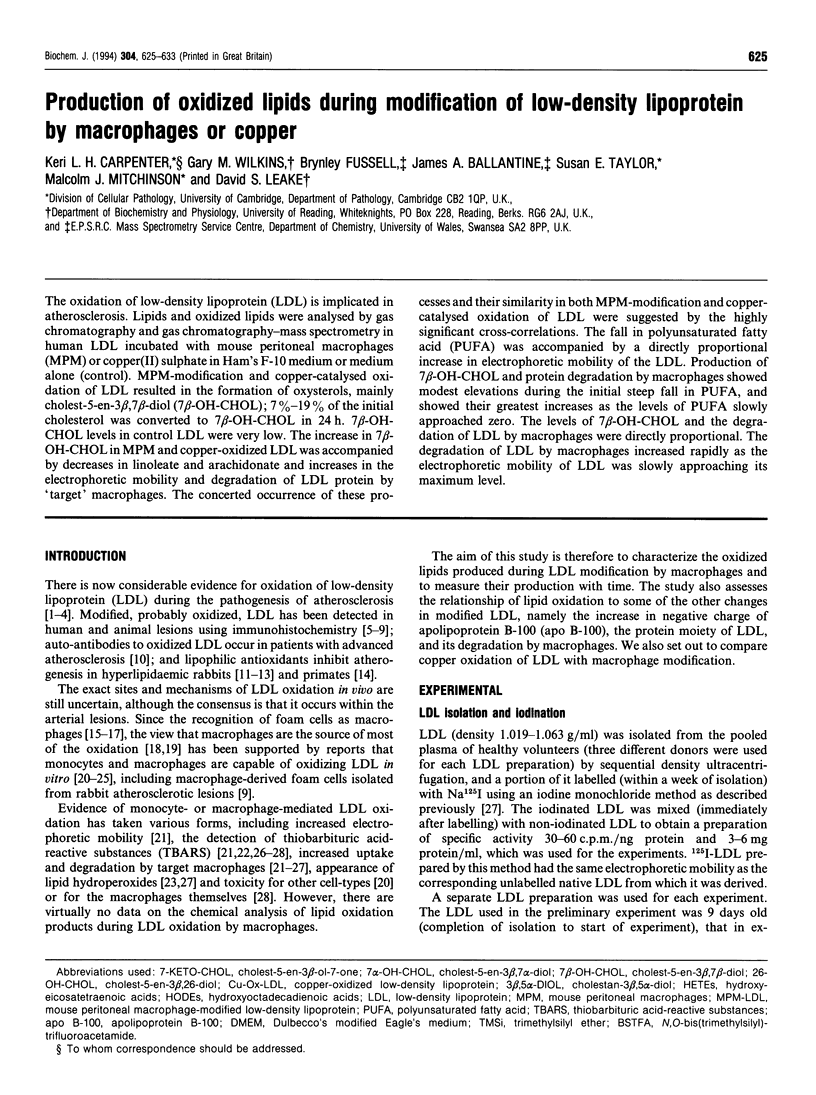
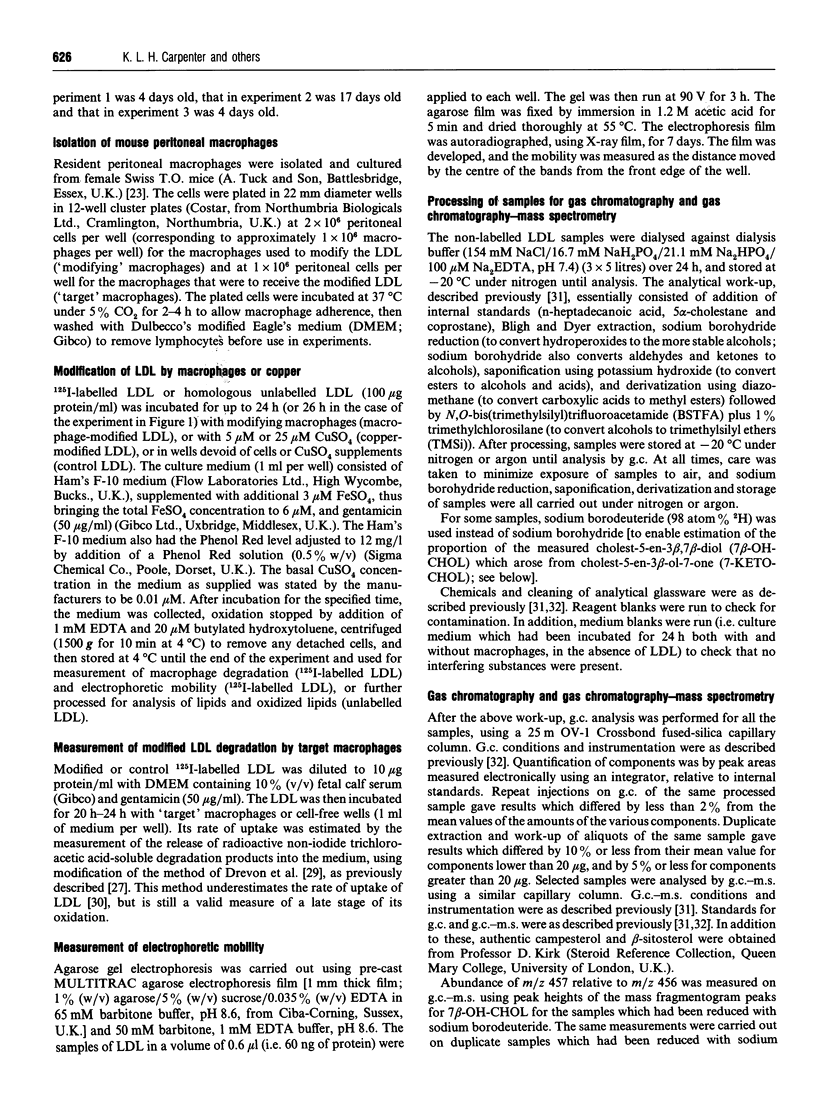
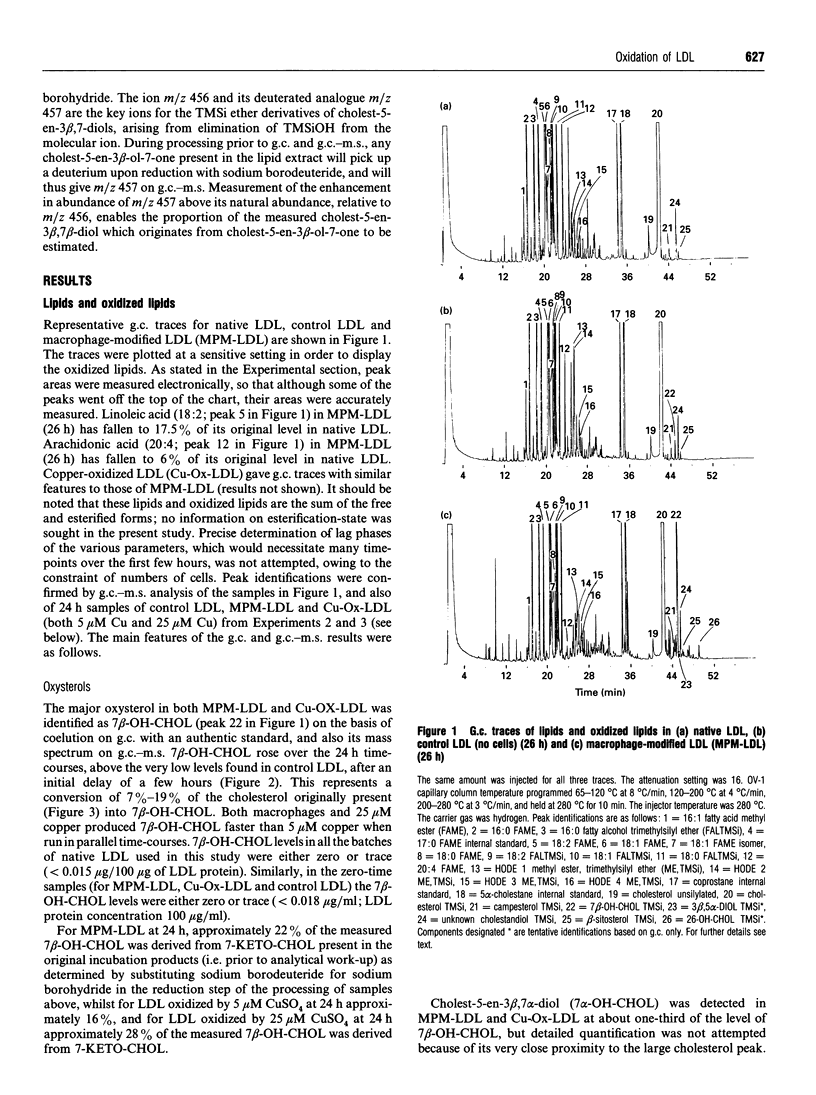
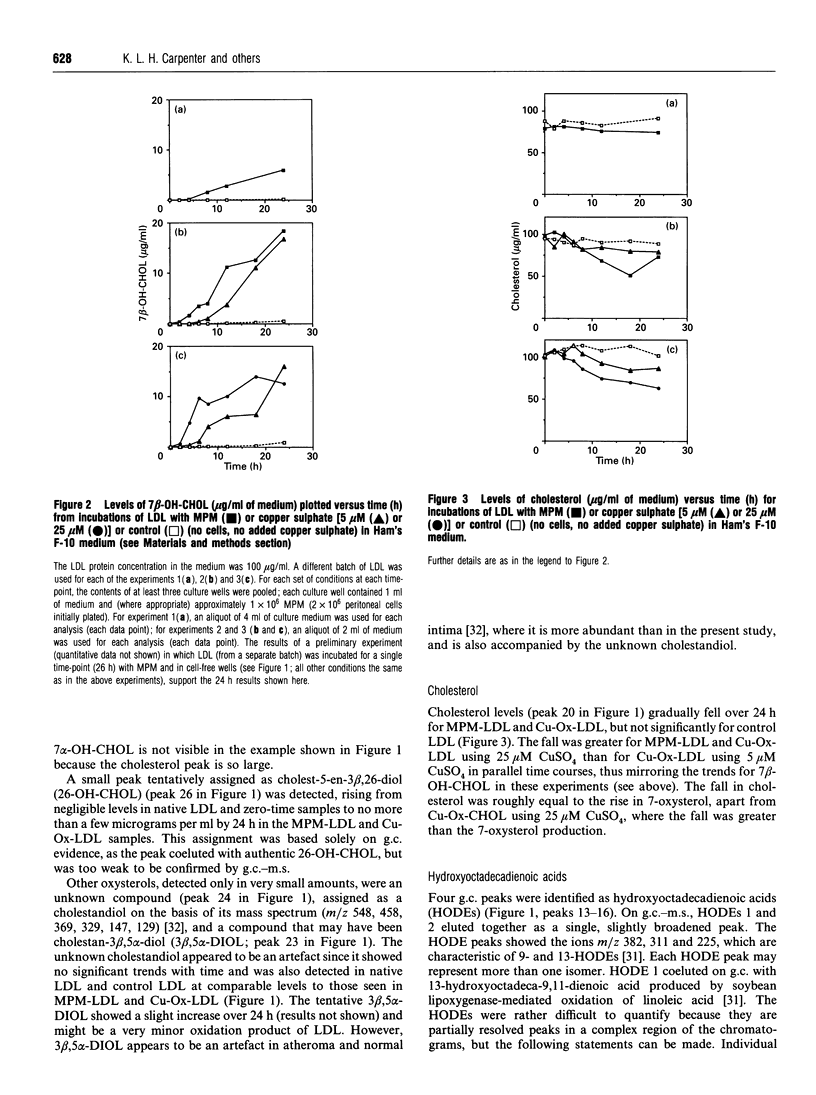
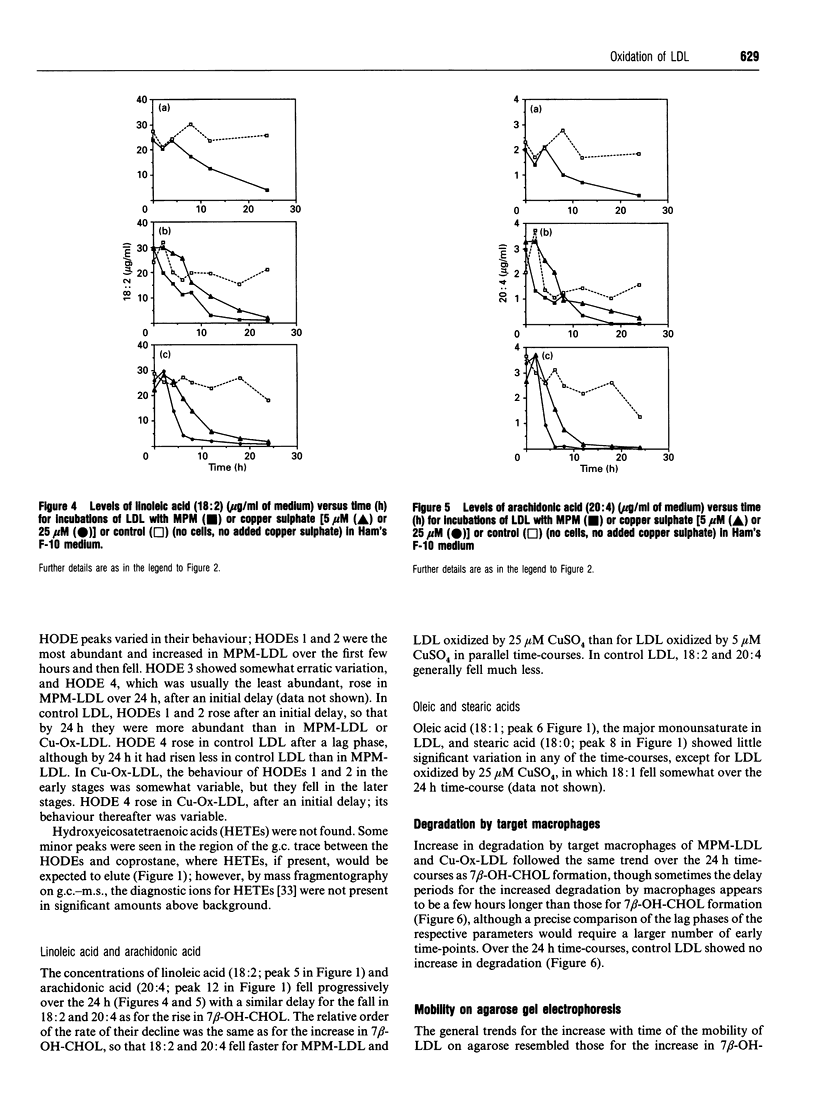
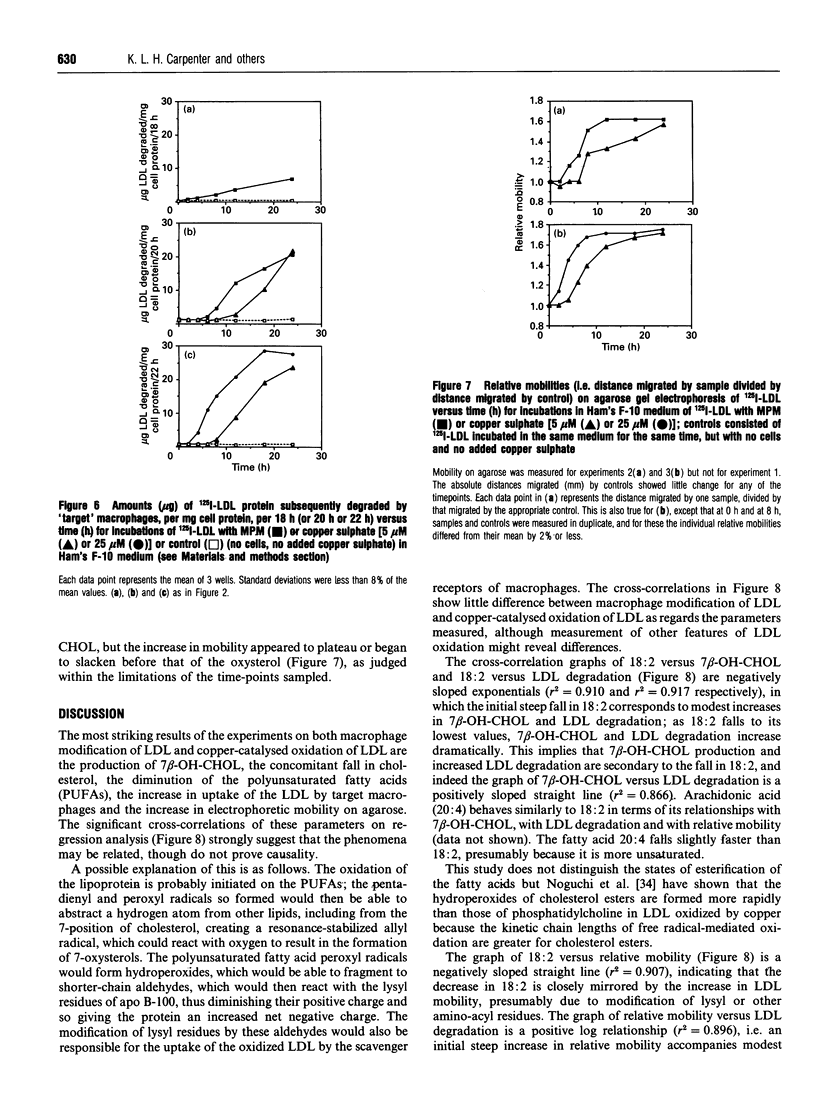
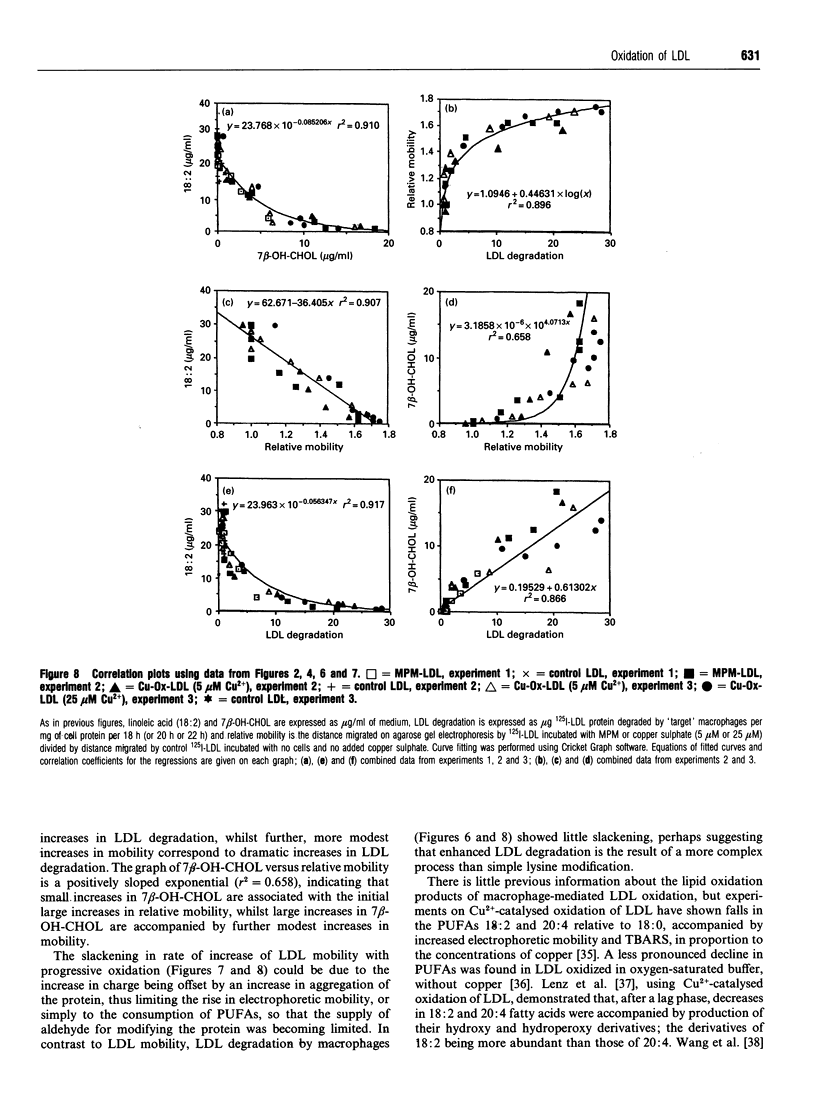
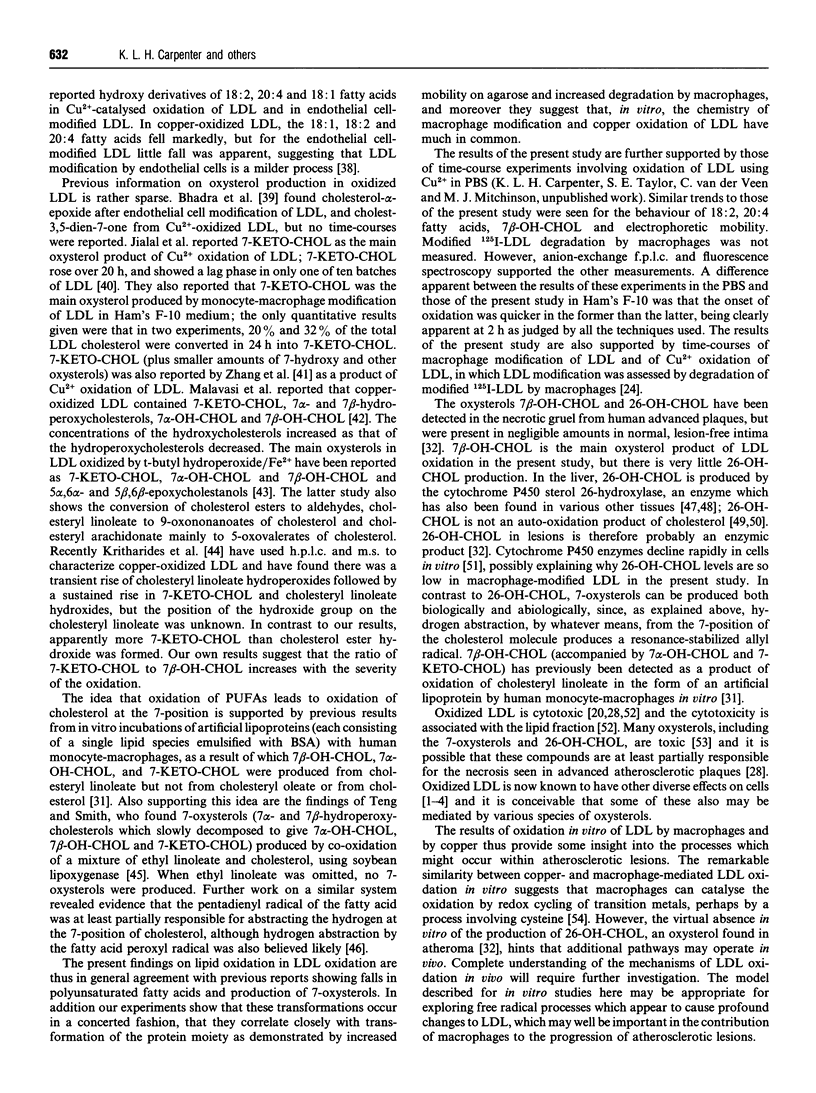
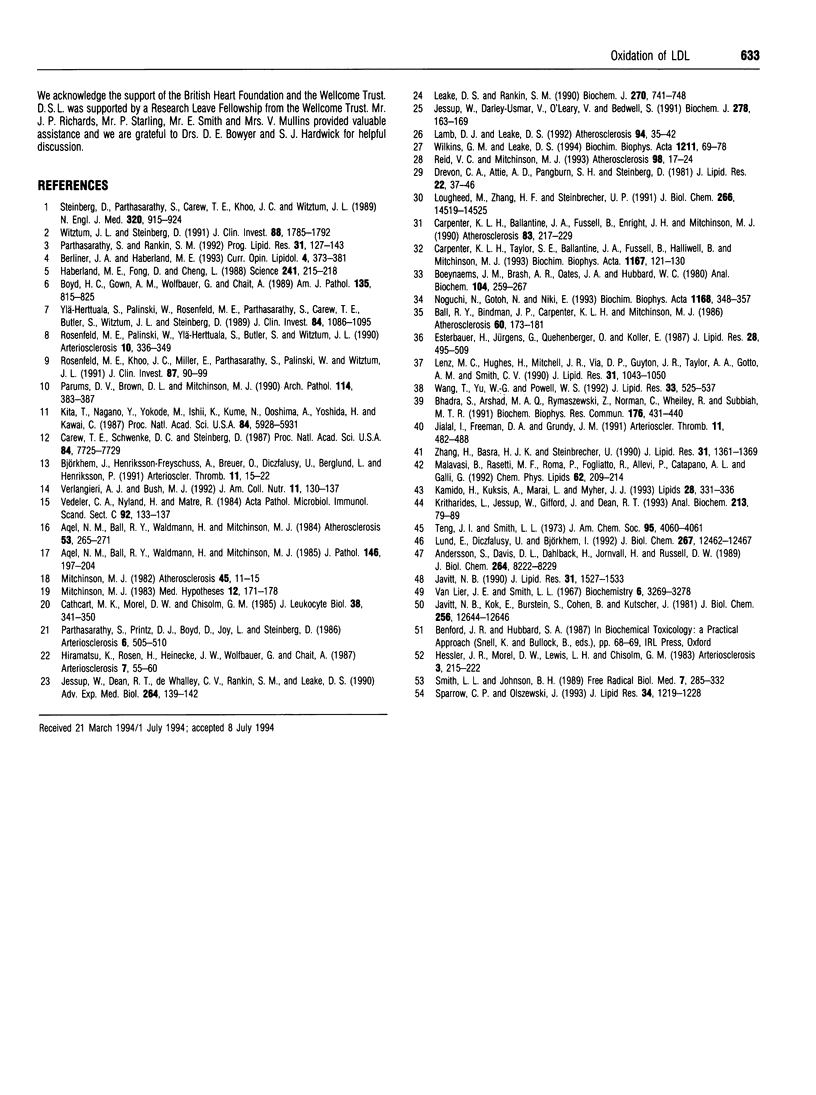
Selected References
These references are in PubMed. This may not be the complete list of references from this article.
- Andersson S., Davis D. L., Dahlbäck H., Jörnvall H., Russell D. W. Cloning, structure, and expression of the mitochondrial cytochrome P-450 sterol 26-hydroxylase, a bile acid biosynthetic enzyme. J Biol Chem. 1989 May 15;264(14):8222–8229. [PubMed] [Google Scholar]
- Aqel N. M., Ball R. Y., Waldmann H., Mitchinson M. J. Identification of macrophages and smooth muscle cells in human atherosclerosis using monoclonal antibodies. J Pathol. 1985 Jul;146(3):197–204. doi: 10.1002/path.1711460306. [DOI] [PubMed] [Google Scholar]
- Aqel N. M., Ball R. Y., Waldmann H., Mitchinson M. J. Monocytic origin of foam cells in human atherosclerotic plaques. Atherosclerosis. 1984 Dec;53(3):265–271. doi: 10.1016/0021-9150(84)90127-8. [DOI] [PubMed] [Google Scholar]
- Ball R. Y., Bindman J. P., Carpenter K. L., Mitchinson M. J. Oxidized low density lipoprotein induces ceroid accumulation by murine peritoneal macrophages in vitro. Atherosclerosis. 1986 May;60(2):173–181. doi: 10.1016/0021-9150(86)90009-2. [DOI] [PubMed] [Google Scholar]
- Bhadra S., Arshad M. A., Rymaszewski Z., Norman E., Wherley R., Subbiah M. T. Oxidation of cholesterol moiety of low density lipoprotein in the presence of human endothelial cells or Cu+2 ions: identification of major products and their effects. Biochem Biophys Res Commun. 1991 Apr 15;176(1):431–440. doi: 10.1016/0006-291x(91)90942-z. [DOI] [PubMed] [Google Scholar]
- Björkhem I., Henriksson-Freyschuss A., Breuer O., Diczfalusy U., Berglund L., Henriksson P. The antioxidant butylated hydroxytoluene protects against atherosclerosis. Arterioscler Thromb. 1991 Jan-Feb;11(1):15–22. doi: 10.1161/01.atv.11.1.15. [DOI] [PubMed] [Google Scholar]
- Boeynaems J. M., Brash A. R., Oates J. A., Hubbard W. C. Preparation and assay of monohydroxy-eicosatetraenoic acids. Anal Biochem. 1980 May 15;104(2):259–267. doi: 10.1016/0003-2697(80)90073-1. [DOI] [PubMed] [Google Scholar]
- Boyd H. C., Gown A. M., Wolfbauer G., Chait A. Direct evidence for a protein recognized by a monoclonal antibody against oxidatively modified LDL in atherosclerotic lesions from a Watanabe heritable hyperlipidemic rabbit. Am J Pathol. 1989 Nov;135(5):815–825. [PMC free article] [PubMed] [Google Scholar]
- Carew T. E., Schwenke D. C., Steinberg D. Antiatherogenic effect of probucol unrelated to its hypocholesterolemic effect: evidence that antioxidants in vivo can selectively inhibit low density lipoprotein degradation in macrophage-rich fatty streaks and slow the progression of atherosclerosis in the Watanabe heritable hyperlipidemic rabbit. Proc Natl Acad Sci U S A. 1987 Nov;84(21):7725–7729. doi: 10.1073/pnas.84.21.7725. [DOI] [PMC free article] [PubMed] [Google Scholar]
- Carpenter K. L., Ballantine J. A., Fussell B., Enright J. H., Mitchinson M. J. Oxidation of cholesteryl linoleate by human monocyte-macrophages in vitro. Atherosclerosis. 1990 Aug;83(2-3):217–229. doi: 10.1016/0021-9150(90)90167-h. [DOI] [PubMed] [Google Scholar]
- Carpenter K. L., Taylor S. E., Ballantine J. A., Fussell B., Halliwell B., Mitchinson M. J. Lipids and oxidised lipids in human atheroma and normal aorta. Biochim Biophys Acta. 1993 Apr 7;1167(2):121–130. doi: 10.1016/0005-2760(93)90151-x. [DOI] [PubMed] [Google Scholar]
- Cathcart M. K., Morel D. W., Chisolm G. M., 3rd Monocytes and neutrophils oxidize low density lipoprotein making it cytotoxic. J Leukoc Biol. 1985 Aug;38(2):341–350. doi: 10.1002/jlb.38.2.341. [DOI] [PubMed] [Google Scholar]
- Drevon C. A., Attie A. D., Pangburn S. H., Steinberg D. Metabolism of homologous and heterologous lipoproteins by cultured rat and human skin fibroblasts. J Lipid Res. 1981 Jan;22(1):37–46. [PubMed] [Google Scholar]
- Esterbauer H., Jürgens G., Quehenberger O., Koller E. Autoxidation of human low density lipoprotein: loss of polyunsaturated fatty acids and vitamin E and generation of aldehydes. J Lipid Res. 1987 May;28(5):495–509. [PubMed] [Google Scholar]
- Haberland M. E., Fong D., Cheng L. Malondialdehyde-altered protein occurs in atheroma of Watanabe heritable hyperlipidemic rabbits. Science. 1988 Jul 8;241(4862):215–218. doi: 10.1126/science.2455346. [DOI] [PubMed] [Google Scholar]
- Hessler J. R., Morel D. W., Lewis L. J., Chisolm G. M. Lipoprotein oxidation and lipoprotein-induced cytotoxicity. Arteriosclerosis. 1983 May-Jun;3(3):215–222. doi: 10.1161/01.atv.3.3.215. [DOI] [PubMed] [Google Scholar]
- Hiramatsu K., Rosen H., Heinecke J. W., Wolfbauer G., Chait A. Superoxide initiates oxidation of low density lipoprotein by human monocytes. Arteriosclerosis. 1987 Jan-Feb;7(1):55–60. doi: 10.1161/01.atv.7.1.55. [DOI] [PubMed] [Google Scholar]
- Javitt N. B. 26-Hydroxycholesterol: synthesis, metabolism, and biologic activities. J Lipid Res. 1990 Sep;31(9):1527–1533. [PubMed] [Google Scholar]
- Javitt N. B., Kok E., Burstein S., Cohen B., Kutscher J. 26-Hydroxycholesterol. Identification and quantitation in human serum. J Biol Chem. 1981 Dec 25;256(24):12644–12646. [PubMed] [Google Scholar]
- Jessup W., Darley-Usmar V., O'Leary V., Bedwell S. 5-Lipoxygenase is not essential in macrophage-mediated oxidation of low-density lipoprotein. Biochem J. 1991 Aug 15;278(Pt 1):163–169. doi: 10.1042/bj2780163. [DOI] [PMC free article] [PubMed] [Google Scholar]
- Jessup W., Dean R. T., de Whalley C. V., Rankin S. M., Leake D. S. The role of oxidative modification and antioxidants in LDL metabolism and atherosclerosis. Adv Exp Med Biol. 1990;264:139–142. doi: 10.1007/978-1-4684-5730-8_20. [DOI] [PubMed] [Google Scholar]
- Jialal I., Freeman D. A., Grundy S. M. Varying susceptibility of different low density lipoproteins to oxidative modification. Arterioscler Thromb. 1991 May-Jun;11(3):482–488. doi: 10.1161/01.atv.11.3.482. [DOI] [PubMed] [Google Scholar]
- Kamido H., Kuksis A., Marai L., Myher J. J. Identification of core aldehydes among in vitro peroxidation products of cholesteryl esters. Lipids. 1993 Apr;28(4):331–336. doi: 10.1007/BF02536319. [DOI] [PubMed] [Google Scholar]
- Kita T., Nagano Y., Yokode M., Ishii K., Kume N., Ooshima A., Yoshida H., Kawai C. Probucol prevents the progression of atherosclerosis in Watanabe heritable hyperlipidemic rabbit, an animal model for familial hypercholesterolemia. Proc Natl Acad Sci U S A. 1987 Aug;84(16):5928–5931. doi: 10.1073/pnas.84.16.5928. [DOI] [PMC free article] [PubMed] [Google Scholar]
- Kritharides L., Jessup W., Gifford J., Dean R. T. A method for defining the stages of low-density lipoprotein oxidation by the separation of cholesterol- and cholesteryl ester-oxidation products using HPLC. Anal Biochem. 1993 Aug 15;213(1):79–89. doi: 10.1006/abio.1993.1389. [DOI] [PubMed] [Google Scholar]
- Lamb D. J., Leake D. S. The effect of EDTA on the oxidation of low density lipoprotein. Atherosclerosis. 1992 May;94(1):35–42. doi: 10.1016/0021-9150(92)90185-j. [DOI] [PubMed] [Google Scholar]
- Leake D. S., Rankin S. M. The oxidative modification of low-density lipoproteins by macrophages. Biochem J. 1990 Sep 15;270(3):741–748. doi: 10.1042/bj2700741. [DOI] [PMC free article] [PubMed] [Google Scholar]
- Lenz M. L., Hughes H., Mitchell J. R., Via D. P., Guyton J. R., Taylor A. A., Gotto A. M., Jr, Smith C. V. Lipid hydroperoxy and hydroxy derivatives in copper-catalyzed oxidation of low density lipoprotein. J Lipid Res. 1990 Jun;31(6):1043–1050. [PubMed] [Google Scholar]
- Lougheed M., Zhang H. F., Steinbrecher U. P. Oxidized low density lipoprotein is resistant to cathepsins and accumulates within macrophages. J Biol Chem. 1991 Aug 5;266(22):14519–14525. [PubMed] [Google Scholar]
- Lund E., Diczfalusy U., Björkhem I. On the mechanism of oxidation of cholesterol at C-7 in a lipoxygenase system. J Biol Chem. 1992 Jun 25;267(18):12462–12467. [PubMed] [Google Scholar]
- Malavasi B., Rasetti M. F., Roma P., Fogliatto R., Allevi P., Catapano A. L., Galli G. Evidence for the presence of 7-hydroperoxycholest-5-en-3 beta-ol in oxidized human LDL. Chem Phys Lipids. 1992 Oct;62(3):209–214. doi: 10.1016/0009-3084(92)90057-v. [DOI] [PubMed] [Google Scholar]
- Mitchinson M. J. Insoluble lipids in human atherosclerotic plaques. Atherosclerosis. 1982 Oct;45(1):11–15. doi: 10.1016/0021-9150(82)90167-8. [DOI] [PubMed] [Google Scholar]
- Mitchinson M. J. Macrophages, oxidised lipids and atherosclerosis. Med Hypotheses. 1983 Oct;12(2):171–178. doi: 10.1016/0306-9877(83)90079-8. [DOI] [PubMed] [Google Scholar]
- Noguchi N., Gotoh N., Niki E. Dynamics of the oxidation of low density lipoprotein induced by free radicals. Biochim Biophys Acta. 1993 Jul 1;1168(3):348–357. [PubMed] [Google Scholar]
- Parthasarathy S., Printz D. J., Boyd D., Joy L., Steinberg D. Macrophage oxidation of low density lipoprotein generates a modified form recognized by the scavenger receptor. Arteriosclerosis. 1986 Sep-Oct;6(5):505–510. doi: 10.1161/01.atv.6.5.505. [DOI] [PubMed] [Google Scholar]
- Parthasarathy S., Rankin S. M. Role of oxidized low density lipoprotein in atherogenesis. Prog Lipid Res. 1992;31(2):127–143. doi: 10.1016/0163-7827(92)90006-5. [DOI] [PubMed] [Google Scholar]
- Parums D. V., Brown D. L., Mitchinson M. J. Serum antibodies to oxidized low-density lipoprotein and ceroid in chronic periaortitis. Arch Pathol Lab Med. 1990 Apr;114(4):383–387. [PubMed] [Google Scholar]
- Reid V. C., Mitchinson M. J. Toxicity of oxidised low density lipoprotein towards mouse peritoneal macrophages in vitro. Atherosclerosis. 1993 Jan 4;98(1):17–24. doi: 10.1016/0021-9150(93)90219-k. [DOI] [PubMed] [Google Scholar]
- Rosenfeld M. E., Khoo J. C., Miller E., Parthasarathy S., Palinski W., Witztum J. L. Macrophage-derived foam cells freshly isolated from rabbit atherosclerotic lesions degrade modified lipoproteins, promote oxidation of low-density lipoproteins, and contain oxidation-specific lipid-protein adducts. J Clin Invest. 1991 Jan;87(1):90–99. doi: 10.1172/JCI115006. [DOI] [PMC free article] [PubMed] [Google Scholar]
- Rosenfeld M. E., Palinski W., Ylä-Herttuala S., Butler S., Witztum J. L. Distribution of oxidation specific lipid-protein adducts and apolipoprotein B in atherosclerotic lesions of varying severity from WHHL rabbits. Arteriosclerosis. 1990 May-Jun;10(3):336–349. doi: 10.1161/01.atv.10.3.336. [DOI] [PubMed] [Google Scholar]
- Smith L. L., Johnson B. H. Biological activities of oxysterols. Free Radic Biol Med. 1989;7(3):285–332. doi: 10.1016/0891-5849(89)90136-6. [DOI] [PubMed] [Google Scholar]
- Sparrow C. P., Olszewski J. Cellular oxidation of low density lipoprotein is caused by thiol production in media containing transition metal ions. J Lipid Res. 1993 Jul;34(7):1219–1228. [PubMed] [Google Scholar]
- Steinberg D., Parthasarathy S., Carew T. E., Khoo J. C., Witztum J. L. Beyond cholesterol. Modifications of low-density lipoprotein that increase its atherogenicity. N Engl J Med. 1989 Apr 6;320(14):915–924. doi: 10.1056/NEJM198904063201407. [DOI] [PubMed] [Google Scholar]
- Teng J. I., Smith L. L. Sterol metabolism. XXIV. On the unlikely participation of singlet molecular oxygen in several enzyme oxygenations. J Am Chem Soc. 1973 Jun 13;95(12):4060–4061. doi: 10.1021/ja00793a045. [DOI] [PubMed] [Google Scholar]
- Van Lier J. E., Smith L. L. Sterol metabolism. I. 26-Hydroxycholesterol in the human aorta. Biochemistry. 1967 Oct;6(10):3269–3278. doi: 10.1021/bi00862a037. [DOI] [PubMed] [Google Scholar]
- Vedeler C. A., Nyland H., Matre R. In situ characterization of the foam cells in early human atherosclerotic lesions. Acta Pathol Microbiol Immunol Scand C. 1984 Apr;92(2):133–137. doi: 10.1111/j.1699-0463.1984.tb00064.x. [DOI] [PubMed] [Google Scholar]
- Wang T., Yu W. G., Powell W. S. Formation of monohydroxy derivatives of arachidonic acid, linoleic acid, and oleic acid during oxidation of low density lipoprotein by copper ions and endothelial cells. J Lipid Res. 1992 Apr;33(4):525–537. [PubMed] [Google Scholar]
- Wilkins G. M., Leake D. S. The effect of inhibitors of free radical generating-enzymes on low-density lipoprotein oxidation by macrophages. Biochim Biophys Acta. 1994 Feb 10;1211(1):69–78. doi: 10.1016/0005-2760(94)90140-6. [DOI] [PubMed] [Google Scholar]
- Witztum J. L., Steinberg D. Role of oxidized low density lipoprotein in atherogenesis. J Clin Invest. 1991 Dec;88(6):1785–1792. doi: 10.1172/JCI115499. [DOI] [PMC free article] [PubMed] [Google Scholar]
- Ylä-Herttuala S., Palinski W., Rosenfeld M. E., Parthasarathy S., Carew T. E., Butler S., Witztum J. L., Steinberg D. Evidence for the presence of oxidatively modified low density lipoprotein in atherosclerotic lesions of rabbit and man. J Clin Invest. 1989 Oct;84(4):1086–1095. doi: 10.1172/JCI114271. [DOI] [PMC free article] [PubMed] [Google Scholar]
- Zhang H. F., Basra H. J., Steinbrecher U. P. Effects of oxidatively modified LDL on cholesterol esterification in cultured macrophages. J Lipid Res. 1990 Aug;31(8):1361–1369. [PubMed] [Google Scholar]


